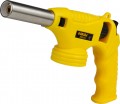Max. temperature
The maximum temperature of the flame produced by the heater. Note that this indicator may be lower than the theoretical fuel combustion temperature — this is due to the physical features of the process.
In general, the more heat-resistant the material you plan to work with, the higher the flame temperature should be. Also, the required temperature may vary for different types of work: for example, oxyfuel cutting does not require as much heat as welding. Detailed recommendations regarding the optimal temperature for different tasks and materials can be found in special sources.
Max. fuel consumption
The maximum fuel consumption during the operation of the device. Usually, it is achieved at maximum power. Knowing this parameter, it is possible to estimate how long the device can be guaranteed to operate on a certain amount of fuel (the actual operating time may be even longer).
Cutting / soldering torch length
Total length of torch or torch (see the relevant paragraph).
Such devices can have different lengths, and each option has its own characteristics. So, short burners and cutters provide better accuracy when working, the movement of such a tool is easier to control; in addition, they are convenient in storage and transportation, because they take up little space. The long length, in turn, provides additional safety: the heating point is at a great distance from the user, thereby reducing the risk that sparks or splashes of molten metal will reach the person. The shortest modern models have a length of about 150 mm, in the longest this size can exceed 1.2 m.
Weight
The total weight of the tool. For models equipped with their own fuel tank, the “dry” weight is indicated, excluding fuel; similarly, the weight of the fuel bottle is not taken into account in devices that look like a bottle cap.

